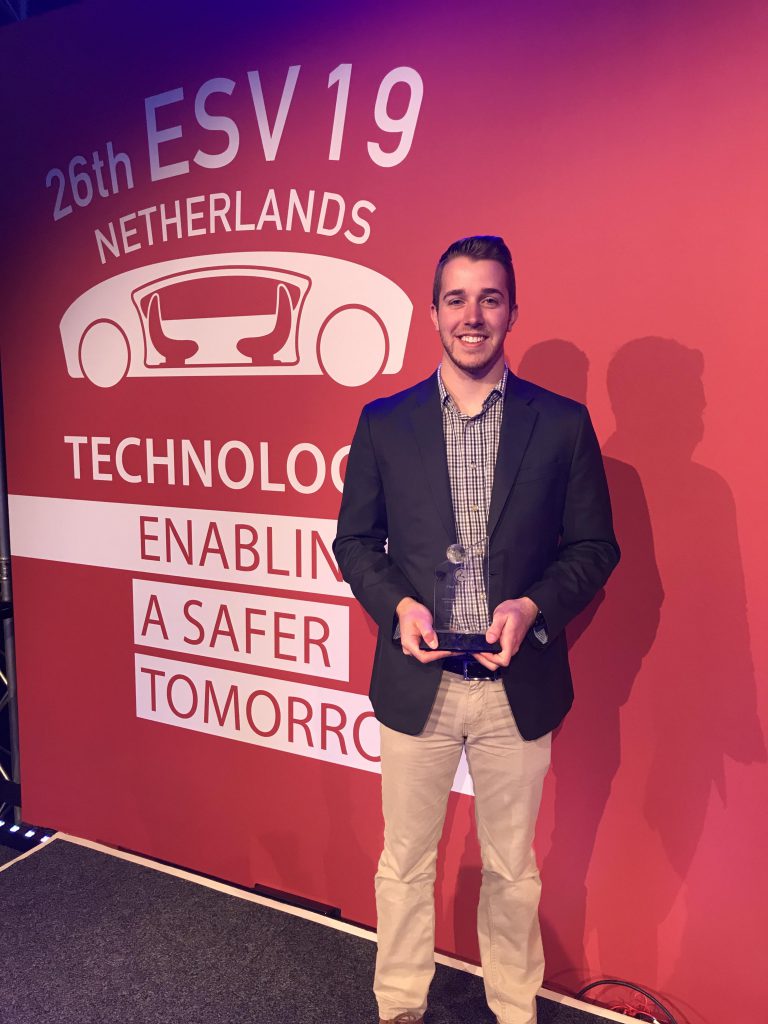
Adam Novotny is a Safe-D student at VT/VTTI working on Safe-D Student Support Project PREPARES. Read his Safe-D Student interview, conducted by Lexi Basantis (VT/VTTI), below!
What are your research interests?
My primary research interests are human factors, biomechanics, and driving performance in relation to advanced vehicle safety systems. I am also interested in autonomous and connected vehicle technology.
How did you end up participating on a Safe-D project?
The Safe-D project that I am currently working on, PREPARES (Pre Rear-End Positioning and Risk Extenuation System) started out as class project as part of the Advanced Vehicle Safety Systems course at Virginia Tech taught by VTTI’s Dr. Zachary Doerzaph. The project required the students in the class to identify a gap in vehicle safety technology and develop a solution to address it. The team chose to focus on stationary rear-end collisions from the perspective of the struck vehicle and how to possibly mitigate the injuries seen in these collisions that are caused by an occupant being out-of-position prior to impact. The system alerts the occupants of the struck vehicle through a bimodal cue that captures their attention and causes them to naturally get back into a proper seated position. After the course concluded, the team chose to continue the project by developing the physical system, conducting a participant study in a controlled access garage bay at VTTI’s Automation Hub, and entering the project in the Enhanced Safety of Vehicles (ESV) Student Technology Design Competition (SDTC). During these stages, it was funded by Safe-D.
What is your role on the Safe-D project that you are working on? Describe what responsibilities you have, or will have, as a project team member.
From the beginning of the project until recently, I was a team member. I was responsible for working on sensor testing and validation, integration of components, participant testing, data/video analysis, and report/presentation contribution. Recently, I have started to take a lead on the project to continue advancing PREPARES. I have written an in-the-works journal article about the early stages in the development, testing, and results of PREPARES, gave a presentation on PREPARES at the FAST-Zero Conference in September, and am now working on a proposal for the next steps that need to be taken to get PREPARES into vehicles. This project will also most likely serve as my PhD dissertation topic, in which case extensive testing will be done on PREPARES and hopefully some new crash-injury biomechanics models for out-of-position occupants can be developed.
What do you like most about participating on this Safe-D project?
I really enjoy all of the different aspects that this project encompasses, from human factors to display design to vehicle safety systems to biomechanics. It has a lot of the areas that I am very interested in researching. I have also enjoyed working with all of the members on the PREPARES team. It is a great group of people who are all very passionate about the project, which showed when we competed in the ESV STDC in the Netherlands this past June and won first place for our design.
What has working on this project allowed you to learn/do/practice?
Working on this project has given me a lot of experience in designing and conducting human participant studies, performing naturalistic data collection, testing sensors, writing papers and giving presentations, which has definitely helped me to become a better researcher at VTTI.
How has/will this project benefit your education and future career goals?
Throughout the entire process for this project, I have gained a wealth of knowledge on advanced vehicle safety systems, human participant studies, designing experiments, as well as how to communicate the results of the study through papers and conference presentations. I am hoping to use the knowledge that I gained to improve my research during my PhD studies and to get a job in the automotive industry following graduation.
Is your Safe-D project contributing to your thesis or dissertation? If so, when do you expect to complete your thesis/dissertation? If not, describe your thesis/dissertation topic and when you expect to complete it.
This project will most likely be the main topic for my dissertation. I am hoping to complete my dissertation by May of 2022. The new portion of the study will involve designing more advanced display designs, conducting higher-fidelity participant studies on all occupants in the vehicle, and developing out-of-position rear-end collision crash injury biomechanics models.
What are your career goals? If you are nearing graduation and have already taken an employment position after graduation, which institution will you be working for?
After I complete my PhD in Biomedical Engineering at Virginia Tech, I would like to continue working in the automotive field. I really enjoy the research and development side of things, so either a job working on creating and improving advanced vehicle safety systems in higher level vehicles or creating standards for advanced vehicles sounds great to me.
The Safe-D Student and Faculty Interview Chain was created to encourage Safe-D students to facilitate contact with faculty and staff members participating on Safe-D projects via conducting a brief interview as a networking and career-building opportunity. To learn more about this initiative, please contact Safe-D Program Manager, Eric Glenn.
